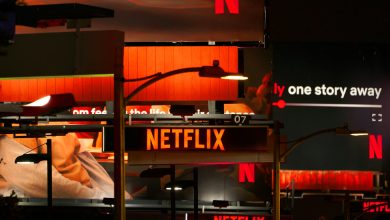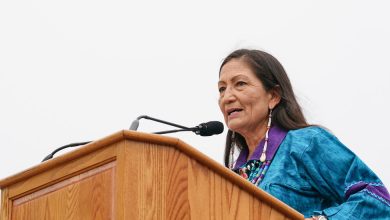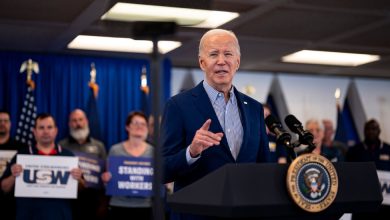Netflix, Still Reeling, Bets Big on ‘The Gray Man’

Anthony and Joe Russo like to go big.
In 2018’s “Avengers: Infinity War,” the directing brothers shocked fans when they erased half the global population and allowed their Marvel superheroes to fail. The next year, they raised the stakes with the three-hour “Avengers: Endgame,” a film that made $2.79 billion at the global box office, the second-highest figure ever to that point.
And now there is “The Gray Man,” a Netflix film that they wrote, directed and produced. The streaming service gave them close to $200 million to trot around the world and have Ryan Gosling and Chris Evans portray shadow employees of the C.I.A. who are trying to kill each other.
“It almost killed us,” Joe Russo said of filming.
One action sequence took a month to produce. It involved large guns, a tram car barreling through Prague’s Old Town quarter and Mr. Gosling fighting off an army of assassins while handcuffed to a stone bench. It’s one of those showstoppers that get audiences cheering. The moment cost roughly $40 million to make.
“It’s a movie within a movie,” Anthony Russo said.
“The Gray Man,” which opened in select theaters this weekend and will be available on Netflix on Friday, is the streaming service’s most expensive film and perhaps its biggest gamble as it tries to create a spy franchise in the mold of James Bond or “Mission Impossible.” Should it work, the Russos have plans for expanding the “Gray Man” universe with additional films and television series, as Disney has done with its Marvel and Star Wars franchises.

Ryan Gosling stars in “The Gray Man,” which Netflix will start streaming on Friday.Credit…Netflix
But those franchises, while turbocharged by streaming and integral to the ambitions of Disney+, are first and foremost theatrical enterprises. “The Gray Man” is coming out in 450 theaters. That’s a far cry from the 2,000 or so that a typical big-budget release would appear in on its opening weekend. And the film’s nearly simultaneous availability on Netflix ensures that most viewers will watch it on the service. Films that Netflix releases in theaters typically leave them much faster than movies from traditional studios.
“If you’re trying to build a franchise, why would you start it on a streaming service?” asked Anthony Palomba, a professor at the University of Virginia’s Darden School of Business who studies media and entertainment trends, specifically how consumers’ habits change.
The film comes at a critical time for Netflix, which will announce its second-quarter earnings on Tuesday. Many in the industry expect the results to be even grimmer than the loss of two million subscribers that the company forecast in April. The company’s first-quarter earnings led to a precipitous drop in its stock price, and it has since laid off hundreds of employees, announced that it will create a less expensive subscription tier featuring commercials and said it plans to crack down on password sharing between friends and family.
Despite the current rough patch, Netflix’s deep pockets and hands-off approach to creative decisions made it the only studio that was able to match the Russos’ ambitions and their quest for autonomy.
“It would have been a dramatically different film,” Joe Russo said, referring to the possibility of making “The Gray Man” at another studio, like Sony, where it was originally set to be produced. The brothers said going elsewhere would have required them to shave off a third of their budget and downgrade the action of the film.
One person with knowledge of the Sony deal said the studio had been willing to pay $70 million to make the movie. Instead, the Russos sold it to Netflix in an agreement that allowed Sony to recoup its development costs and receive a fee for its time producing it. Sony declined to comment.
The movie includes nine significant action sequences, including a midair fight involving emergency flares, fire extinguishers and Mr. Gosling’s grappling with a parachuted enemy as both tumble out of a bombed-out plane, Anthony Russo said.
“Ambition is expensive,” Joe Russo said. “And it’s risky.”
Netflix, even in this humbling moment, can pay more upfront when it isn’t saddled with the costs that accompany much bigger theatrical releases. And for Scott Stuber, Netflix’s head of global film, who greenlighted the “Bourne Identity” franchise when he was at Universal Pictures, movies like “The Gray Man” are what he has been striving to make since he joined the company five years ago.
“We haven’t really been in this genre yet,” Mr. Stuber said in an interview. “If you’re going to do it, you want to deal with filmmakers who over the last decade have created some of the biggest franchises and the biggest action movies in our business.”
The Russos are also producing the sequel to “Extraction” with Chris Hemsworth for Netflix and just announced that Netflix would finance and release their next directing venture, a $200 million sci-fi action film, “The Electric State,” with Millie Bobby Brown and Chris Pratt.
Mr. Stuber pointed to the “Extraction” sequel and a spy film starring Gal Gadot, “Heart of Stone,” both set for release next year, as proof that the company is still taking big swings despite its struggles. He did acknowledge, however, that the recent business realities have forced the company to think harder about the projects it selects.
“We’re not crazily reducing our spend, but we’re reducing volume,” he said. “We’re trying to be more thoughtful.”
He added: “We were a business that was, for a long time, a volume business. And now we’re being very specific about targeting.”
Niija Kuykendall was hired from Warner Bros. late last year to oversee a new division that will focus on making midbudget movies, in the range of $40 million to $50 million, which the traditional studios have all but abandoned because their box office potential is less certain. And Mr. Stuber pointed to two upcoming films — “Pain Hustlers,” a $50 million thriller starring Emily Blunt, and an untitled romantic comedy with Nicole Kidman and Zac Efron — as examples of the company’s commitment to films of that size.
In recent months, Netflix has also been criticized by some in the industry for how much — or how little — it spends to market individual films. Its marketing budget has essentially stayed the same for three years, despite a significant rise in competition from services like Disney+ and HBO Max. Creators often wonder whether they are going to get the full Netflix marketing muscle or simply a couple of billboards on Sunset Boulevard.
For “The Gray Man,” Netflix has sent the Russos and their cast to Berlin, London and Mumbai, India. Other promotional efforts have included national television ads during National Basketball Association games and the Indianapolis 500 and 3-D billboards in disparate locations like Las Vegas and Krakow, Poland.
“It’s very large scale,” Joe Russo said of Netflix’s promotion of “The Gray Man.” “We’re doing a world tour to promote it. The actors are going with us. It feels a lot like the work we did to promote the Marvel films.”
For the smaller-scale theatrical release, Netflix will put “The Gray Man” at some of the handful of theaters it owns — like the Paris Theater in New York and the Bay Theater in Los Angeles — and with chains like Cinemark and Marcus Theaters. And even though Joe Russo calls “The Gray Man” “a forget-to-eat-your-popcorn kind of film,” Netflix will not disclose its box office numbers.
The theatrical side of the movie business is a conundrum for Netflix. The studio’s appetite for risk is often greater than that of traditional studios because it doesn’t spend as much money putting films in theaters and doesn’t have to worry about box office numbers. On the flip side, the lack of large-scale theatrical releases has long been a sticking point with filmmakers looking to display their creativity on as big a screen as possible and hoping to build buzz with audiences.
And the strength of the box office in recent months for films as different as “Top Gun: Maverick,” “Minions: The Rise of Gru” and “Everything Everywhere All at Once” (which the Russos produced) has prompted many to rethink the influence of movie theaters, which the pandemic severely hobbled.
Mr. Stuber acknowledged that a greater theatrical presence was a goal, but one that requires a consistent supply of movies that can connect with a global audience.
“That’s what we’re trying to get to: Do we have enough of those films across the board consistently where we can be in that market?” he said.
It would also require Netflix to reckon with how long to let its movies play exclusively in theaters before appearing on its service. While the theatrical window for the “The Gray Man” is very short, the Russos hope the film will show that Netflix can be a home for the type of big-budget crowd pleasers the brothers are known for.
“Knowing that you have, ultimately, a distribution platform which can pull in 100 million viewers like it did on ‘Extraction,’ but also the potential for a large theatrical window with a commensurate promotional campaign behind it,” Joe Russo said, “you have a very powerful studio.”




